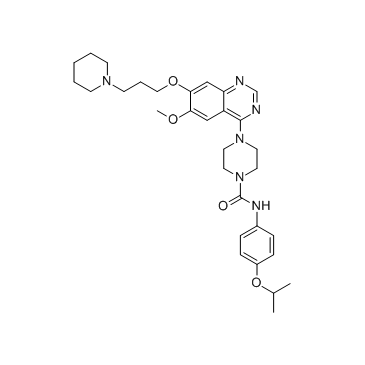387867-13-2
| Name | Tandutinib(CT 53518) |
|---|---|
| Synonyms |
4-(6-methoxy-7-(3-piperidin-1-ylpropoxy)quinazolin-4-yl)piperazine-1-carboxylic acid (4-isopropoxyphenyl)amide
MLN 518 Tandutinib 4-{6-methoxy-7-[3-(piperidin-1-yl)propoxy]quinazolin-4-yl}-N-[4-(propan-2-yloxy)phenyl]piperazine-1-carboxamide N-(4-Isopropoxyphenyl)-4-{6-methoxy-7-[3-(piperidin-1-yl)propoxy]quinazolin-4-yl}piperazine-1-carboxamide Tandutinib for research 1-Piperazinecarboxamide, 4-[6-methoxy-7-[3-(1-piperidinyl)propoxy]-4-quinazolinyl]-N-[4-(1-methylethoxy)phenyl]- N-(4-Isopropoxyphenyl)-4-{6-methoxy-7-[3-(1-piperidinyl)propoxy]-4-quinazolinyl}-1-piperazinecarboxamide UNII:E1IO3ICJ9A Unii-E1io3icj9a |
| Description | Tandutinib (MLN518, CT53518) is a potent FLT3 antagonist with IC50 of 0.22 μM, also inhibits PDGFR and c-Kit, 15 to 20-fold higher potency for FLT3 versus CSF-1R and >100-fold selectivity for the same target versus FGFR, EGFR and KDR. IC50 value: 0.22 uM [1]Target: Flt3; PDGFRβ; c-Kitin vitro: Tandutinib has little activity against EGFR, FGFR, KDR, InsR, Src, Abl, PKC, PKA and MAPKs. Tandutinib inhibits IL-3-independent cell growth and FLT3-ITD autophosphorylation with an IC50 of 10-100 nM. Tandutinib also inhibits the proliferation of human leukemia Ba/F3 cells containing FLT3-ITD mutations with IC50 values of 10-30 nM, and the FLT3-ITD-positive Molm-13 and Molm-14 cells with an IC50 of 10 nM. In FLT3-ITD-positive Molm-14 cells but not the FLT3-ITD-negative THP-1 cells, Tandutinib treatment leads to significant apoptosis by 51% and 78% at 24 and 96 hours, respectively, due to specific FLT3 inhibition [1]. Tandutinib preferentially inhibits the growth of blast colonies from FLT3 ITD-positive compared with ITD-negative patients with AML, without affecting colony formation by normal human progenitor cells [2].in vivo: Oral administration of Tandutinib at 60 mg/kg bid significantly increases the survival in mice bearing Ba/F3 cells expressing W51 FLT3-ITD mutant, and gives a significant reduction in mortality in a mouse bone marrow transplantation model [1]. Tandutinib treatment at 180 mg/kg twice daily has mild toxicity toward normal hematopoiesis, however, it is a dose at which Tandutinib is effective in treating FLT3 ITD-positive leukemia in mice [2]. |
|---|---|
| Related Catalog | |
| References |
| Density | 1.2±0.1 g/cm3 |
|---|---|
| Boiling Point | 769.5±60.0 °C at 760 mmHg |
| Melting Point | 177-178°C |
| Molecular Formula | C31H42N6O4 |
| Molecular Weight | 562.703 |
| Flash Point | 419.2±32.9 °C |
| Exact Mass | 562.326782 |
| PSA | 92.29000 |
| LogP | 3.48 |
| Vapour Pressure | 0.0±2.6 mmHg at 25°C |
| Index of Refraction | 1.611 |
| Storage condition | Refrigerator |
| Hazard Codes | T,N,Xi,F |
|---|---|
| Risk Phrases | R25:Toxic if swallowed. R34:Causes burns. R50:Very Toxic to aquatic organisms. R40:Limited evidence of a carcinogenic effect. R36/37/38:Irritating to eyes, respiratory system and skin . |
| Safety Phrases | S23-S37-S45-S61-S36-S26-S16 |
| RIDADR | UN 1751 6.1/PG 2 |
| WGK Germany | 2 |
| RTECS | AF8575000 |
| Packaging Group | II |
| Hazard Class | 6.1 |
| HS Code | 29154000 |
| HS Code | 29154000 |
|---|
